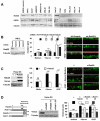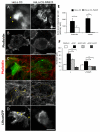Rab25 regulates invasion and metastasis in head and neck cancer
- PMID: 23340300
- PMCID: PMC3602237
- DOI: 10.1158/1078-0432.CCR-12-2858
Rab25 regulates invasion and metastasis in head and neck cancer
Abstract
Purpose: Head and neck squamous cell carcinoma (HNSCC) is one of the 10 most common cancers with a 50% five-year survival rate, which has remained unchanged for the past three decades. One of the major reasons for the aggressiveness of this cancer is that HNSCCs readily metastasize to cervical lymph nodes that are abundant in the head and neck region. Hence, discovering new molecules controlling the metastatic process as well as understanding their regulation at the molecular level are essential for effective therapeutic strategies.
Experimental design: Rab25 expression level was analyzed in HNSCC tissue microarray. We used a combination of intravital microscopy in live animals and immunofluorescence in an in vitro invasion assay to study the role of Rab25 in tumor cell migration and invasion.
Results: In this study, we identified the small GTPase Rab25 as a key regulator of HNSCC metastasis. We observed that Rab25 is downregulated in HNSCC patients. Next, we determined that reexpression of Rab25 in a metastatic cell line is sufficient to block invasion in a three-dimensional collagen matrix and metastasis to cervical lymph nodes in a mouse model for oral cancer. Specifically, Rab25 affects the organization of F-actin at the cell surface, rather than cell proliferation, apoptosis, or tumor angiogenesis.
Conclusion: These findings suggest that Rab25 plays an important role in tumor migration and metastasis, and that understanding its function may lead to the development of new strategies to prevent metastasis in oral cancer patients.
Figures







Similar articles
-
Stable SET knockdown in head and neck squamous cell carcinoma promotes cell invasion and the mesenchymal-like phenotype in vitro, as well as necrosis, cisplatin sensitivity and lymph node metastasis in xenograft tumor models.Mol Cancer. 2014 Feb 20;13:32. doi: 10.1186/1476-4598-13-32. Mol Cancer. 2014. PMID: 24555657 Free PMC article.
-
High RAB25 expression is associated with good clinical outcome in patients with locally advanced head and neck squamous cell carcinoma.Cancer Med. 2013 Dec;2(6):950-63. doi: 10.1002/cam4.153. Epub 2013 Oct 31. Cancer Med. 2013. PMID: 24403269 Free PMC article.
-
Rab25 upregulation correlates with the proliferation, migration, and invasion of renal cell carcinoma.Biochem Biophys Res Commun. 2015 Mar 20;458(4):745-50. doi: 10.1016/j.bbrc.2015.01.144. Epub 2015 Feb 14. Biochem Biophys Res Commun. 2015. PMID: 25686498
-
Actin cytoskeletal mediators of motility and invasion amplified and overexpressed in head and neck cancer.Clin Exp Metastasis. 2008;25(4):289-304. doi: 10.1007/s10585-008-9154-6. Epub 2008 Mar 7. Clin Exp Metastasis. 2008. PMID: 18324357 Review.
-
Insights into metastatic roadmap of head and neck cancer squamous cell carcinoma based on clinical, histopathological and molecular profiles.Mol Biol Rep. 2024 Apr 29;51(1):597. doi: 10.1007/s11033-024-09476-8. Mol Biol Rep. 2024. PMID: 38683372 Free PMC article. Review.
Cited by
-
Rab18 Regulates Proliferation, Invasion and Cisplatin Sensitivity Through STAT3 Signaling in Head and Neck Squamous Cell Carcinoma.Onco Targets Ther. 2020 May 13;13:4123-4134. doi: 10.2147/OTT.S238503. eCollection 2020. Onco Targets Ther. 2020. PMID: 32494165 Free PMC article.
-
The role of the oncogenic Rab35 in cancer invasion, metastasis, and immune evasion, especially in leukemia.Small GTPases. 2020 Sep;11(5):334-345. doi: 10.1080/21541248.2018.1463895. Epub 2018 May 28. Small GTPases. 2020. PMID: 29781368 Free PMC article. Review.
-
Generation of homologous cell pairs using the oral lymphatic system.Int J Clin Exp Pathol. 2014 Mar 15;7(4):1563-71. eCollection 2014. Int J Clin Exp Pathol. 2014. PMID: 24817952 Free PMC article.
-
Galanin modulates the neural niche to favour perineural invasion in head and neck cancer.Nat Commun. 2015 Apr 28;6:6885. doi: 10.1038/ncomms7885. Nat Commun. 2015. PMID: 25917569 Free PMC article.
-
Imaging the dynamics of endocytosis in live mammalian tissues.Cold Spring Harb Perspect Biol. 2014 Apr 1;6(4):a017012. doi: 10.1101/cshperspect.a017012. Cold Spring Harb Perspect Biol. 2014. PMID: 24691962 Free PMC article. Review.
References
-
- Gale NPB, Sidransky D, Westra W, Califano J. Tumours of the hypopharynx, larynx and trachea (Epithelial precursor lesions) In: Barnes LEJ, Reichart P, Sidransky D, editors. World Health Organization Classification of Tumours Pathology & genetics Head and neck tumours International Agency for Research on Cancer (IARC) IARC Press; Lyon: 2005. pp. 140–3.
-
- Haddad RI, Shin DM. Recent Advances in Head and Neck Cancer. New England Journal of Medicine. 2008;359:1143–54. - PubMed
-
- Siegel R, Naishadham D, Jemal A. Cancer statistics, 2012. CA Cancer J Clin. 2012;62:10–29. - PubMed
-
- Ridley AJ. Life at the Leading Edge. Cell. 2011;145:1012–22. - PubMed
Publication types
MeSH terms
Substances
Grants and funding
LinkOut - more resources
Full Text Sources
Other Literature Sources
Medical
Research Materials
Miscellaneous

